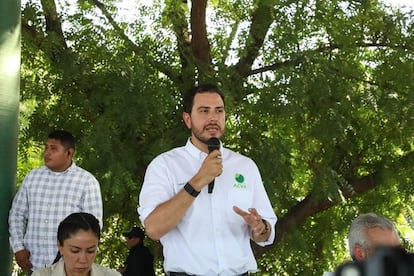Mexico is going through a delicate moment, a situation invisible to statistics. The federal government highlights the progress of its security strategy month after month. Homicides and much of the high-impact crime rate are declining, a reason for celebration after more than 15 years of almost uninterrupted increases. Yet at the same time, a shadow is spreading: the shadow of extortion, a crime practiced by mafias for which authorities seem to have no answer. Where once drug production and trafficking dominated as the main criminal enterprise, extortion schemes are now taking over and becoming increasingly sophisticated.
Extortion cases have risen in recent years, at least in terms of reported complaints, for a crime long known to have a high level of unreported incidents. The executive branch, led by Mexican President Claudia Sheinbaum, launched a special strategy in July to tackle the problem, though its results remain uncertain.
Meanwhile, criminal organizations are expanding. “It all started with a seductive message, the idea of providing protection in exchange for security,” explains Salvador Maldonado, a researcher at the College of Michoacán, specializing in violence and criminality. “Little by little it became more widespread, until it mutated, and now it’s not just about paying for protection, but also the [organized crime groups’] interest in embedding themselves in production chains, in becoming part of the business community,” he adds.
The assassination of the mayor of Uruapan this past weekend, coupled with the fatal attack a few days ago against Bernardo Bravo, representative of the lemon producers of the Apatzingán Valley in Michoacán, reveals a paradigm shift. Bravo represented a guild under siege by local criminal organizations. The classic extortion racket — an informal tax paid to crime to allow production, harvest, and distribution — had evolved into a more complex system. Beyond the extortion fee, criminals sought to act as market regulators, imposing harvest schedules. Furthermore, the criminals were positioning themselves as suppliers of inputs, which farmers were obligated to provide.
Bravo was trying to reach a less exacting agreement. According to information obtained by EL PAÍS, the criminals were asking for two pesos for every kilo of lemons picked and an additional two pesos for every kilo sold, an amount Bravo was trying to lower. The guild leader was also trying to get the criminals to allow them to pick lemons more than three days a week, a recent imposition used to try to control the market price of the citrus fruit. It was in this context that the extortionists murdered Bravo. The criminals reportedly lured him to a town near Apatzingán, killed him, and took his body back to the municipality where his office was located.
 Bernardo Bravo Manríquez in a social media photo on February 25, 2024.@Bernardo Bravo
Bernardo Bravo Manríquez in a social media photo on February 25, 2024.@Bernardo BravoFollowing the murder, various political figures in the region have blamed Los Viagra for the crime — including Guillermo Valencia, a local deputy for the Institutional Revolutionary Party (PRI), who even held a press conference to identify, on a map, the area where the alleged masterminds behind the murder operate.
In an interview with EL PAÍS, Valencia stated that Los Viagra “have supplanted the state in the area in two of its basic functions, because they collect taxes and use the police force, which should be the monopoly of the authorities. Before, the cartels were focused on drug trafficking; now they focus more on this.”
More than a criminal group, Los Viagra are in fact a family clan, one that grew in the wake of North America’s preferred security strategy: tracking down kingpin or crime bosses. The plan assumes that beheading criminal structures reduces their capacity. In reality, what has happened over the years is that, in Mexican regions like Michoacán, a myriad of criminal groups have emerged — often fighting one another — and have turned the economic relations of the societies they inhabit into a source of income. Drug trafficking has thus become a secondary option. Extortion is simpler than moving drugs: it requires no large logistical networks and can easily be disguised as part of the frictions of the productive economy.
That is what happens in Michoacán, as well as in other states, where multiple criminal groups coexist, none able to fully dominate the others. In Guerrero, for instance, different armed actors rooted in distinct municipalities and regions are fighting for control. In these battles, they tap into legal markets — such as poultry production and sales, transportation, or public works — to finance themselves.
As Dr. Beatriz Magaloni, coauthor of Living in Fear: The Dynamics of Extortion in Mexico’s Drug War, explains: “When drug-trafficking organizations control their territories, they can behave like benign bandits and offer help to their neighbors. But as these groups violently compete for control of territory and smuggling routes, they turn on citizens to extort them and extract resources.”
The solution does not appear simple, because over time crime has become interwoven with the economy, creating complex networks that are difficult to untangle.
“Extortion is already part of the machinery of the economic system. Its connections are hard to detect, this process in which multiple layers of extortion become intertwined. And of course, that makes everything more complicated,” explains Maldonado, the researcher at the College of Michoacán. “Dismantling one group or another doesn’t matter so much, because they are already embedded in production chains. If you break one link, all the others remain operational and take over from the one that is freed. In other words, the individuals or groups targeted are now cogs in the machine, and if you remove them, the system readjusts,” he concludes.
Sign up for our weekly newsletter to get more English-language news coverage from EL PAÍS USA Edition
.png)




